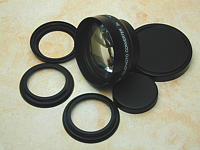
|
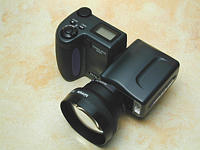
|
| Tiffen's 49mm Telephoto Lens 2X | |
| Click on the image to see a larger one | |
Tiffen has two tele-converters, 1.5X and 2.0X, each of which has two different mounts, 37mm and 49mm. If you do not have any intention to do the combos discussed here on this page, you should go with the 37mm version. Just attach a 28-37mm step-up ring to the lens and screw the whole thing onto your 950/990. The 49mm version is a different story. It comes with three rings, 46mm, 49mm and 52mm. To use this version on a 950/990, step-up rings that can bring the thread size from 28mm to 46mm, 49mm or 52mm are required. The left image below shows the lens, lens caps, and three rings, while the right one shows the converter mounted on a 990 using a 28-37mm and a 37mm-52mm step-up rings. Note that this is not the only choice. For example, one can use the 49mm ring on the converter and go with a 28-37mm followed by a 37-49mm step-up ring. An obvious question: why don't we just use 28-37mm and 37-49mm step-up rings and screw the 49mm end directly on the Tiffen? It simply does not work. You will have difficulty in mounting a 37-49mm step-up ring because the back element of this converter protrudes too much.

|

|
| Tiffen's 49mm Telephoto Lens 2X | |
| Click on the image to see a larger one | |
This converter seems coated and is made by plastic material, including the three rings. However, I believe the lens elements are glass. The thread size is marked on each ring; but, the marking is difficult to read as it is not colored. I am not sure about the durability of these plastic rings. Moreover, this converter is not threaded, making the use of filters difficult.
This is a video converter and has eight elements in five groups. Its size is very small (1.6×3.9) with a 0.75 inch front element. As a result, the LCD monitor is dark and the use of large aperture is perhaps always required. This lens has a 37mm thread and hence a 28-37mm step-up ring is required for mounting this lens on 950/990. The front end of this lens is not threaded and using filters can be difficult. This lens comes with two lens caps and two rings (37-49mm and 37-52mm). It seems coated and has a construction quality better than Tiffen's. Since its power is 5X, the maximum focal length becomes 575mm (35mm equivalent). Unfortunately, due to its tube size, vignetting can be expected as will be shown later on this page.
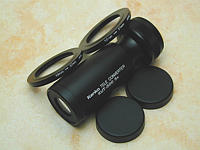
|
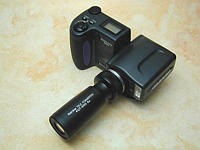
|
| Kenko KUT-500 5.0X Super Compact Tele | |
| Click on the image to see a larger one | |
A Nikon TC-E2 and a Tiffen 2X converter can be screw together to make a 4X (=2×2) converter. Since Tiffen's is not threaded, we need to screw Tiffen's onto of TC-E2. To do so, a step-down ring is required to reduce TC-E2's thread size 62mm to the one that is supported by Tiffen's. The left image below uses the 52mm ring on Tiffen, followed by a 62-52mm step-down ring which is screwed on TC-E2. Since this is a 4X combo, the maximum combined focal length of a 950/990 becomes 460mm (35mm equivalent).

|
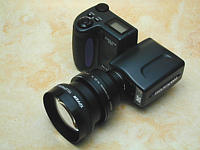
|
| The Tiffen-Nikon (TC-E2) combo | |
| Click on the image to see a larger one | |
The Kenko 5X converter can also be used with TC-E2. Since the back-end thread size of Kenko is 37mm, we can add a 37-52mm step-down ring followed by a 62-52mm step-down ring. Then, screw the whole thing onto TC-E2. Note that a 37-52mm step-down ring comes with the lens. The left image below shows the combo. The combined focal length of this combo is 1150mm (35mm equivalent)!
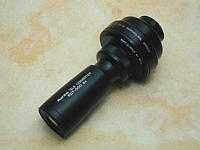
|
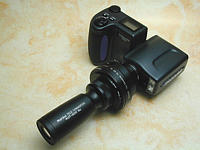
|
| The Kenko-Nikon (TC-E2) combo | |
| Click on the image to see a larger one | |
First, let us get a feeling of the combined focal length. In the following, from left to right, the columns show images taken with Nikon TC-E2, Nikon+Tiffen combo, Kenko 5X, and Nikon+Kenko combo. The on-camera lens is zoomed all the way in (i.e., 115mm, 35mm equivalent), and, as a result, the focal lengths of these four settings are 230mm, 460mm, 575mm, and 1150mm. All images were shot using the largest aperture. Since usually the image quality becomes higher as the aperture stops down, showing the image taken with the largest possible aperture means these are the worst results, and nothing can be worse. To improve quality, just use a smaller aperture when it is possible. (Note that many lens, especially those large aperture long tele lens (e.g., 300mm f2.8, 400mm f2.8, 500mm f4 and 600mm f4), are optimized for the largest aperture. Closing aperture down may reduce image quality.)
Each row has the images of the same subjects. The house on the first row is about 40 yards away; the condo on the second row is more than 400 yards; the building that houses the world largest steam hoist is more than a mile away; and the moon is, of course, at infinity!
| Nikon TC-E2 (2X) | Nikon + Tiffen (4X) | Keno 5X | Nikon + Kenko (10X) |
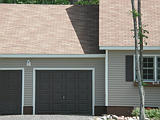
|
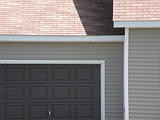
|
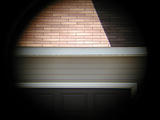
|
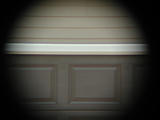
|
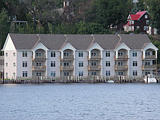
|
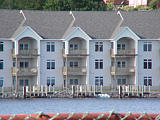
|
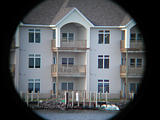
|
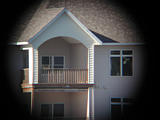
|
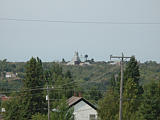
|

|
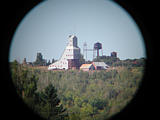
|
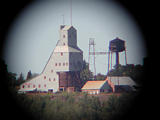
|

|
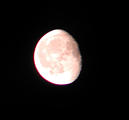
|
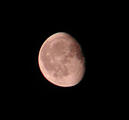
|

|
| Click on the image to see a larger one | |||
From these images, it is easy to see that the Nikon+Tiffen combo performs very well. However, it shows (1) high pincushion distortion, (2) sharp center and soft corners, (3) reasonably high contrast, and (4) good shadow rendition. The Kenko converter also performs well; however, vignetting does occur. This is perhaps because the light gathering tube is small. The center portion of Kenko is good; but, this good area is small and image quality deteriorates quickly toward the edge. It shows good contrast and nice details (see the house roof on the first row and the siding of the condo on the second row). As for the Nikon+Kenko combo, it is difficult to get a very clear shot except the one of the steam hoist house. Judged by th steam hoist image, the Nikon+Kenko's performance is acceptable and has some chromatic aberration. Of course, contrast is considerably lower than using the Nikon or Kenko alone. This is understandable. The center is a little soft, and image quality is getting worse toward the edge.
The major topic here is about the image quality of TC-E2 and Tiffen's 2X Super Telephoto converter. We shall use the house set of images for comparison. The following two images were taken with TC-E2 and Tiffen's.
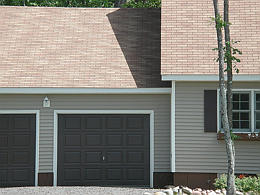
|
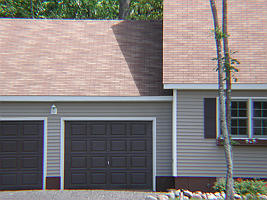
|
| Nikon TC-E2 | Tiffen 2X |
| Click on the image to see a larger one | |
First, we notice that the image taken with TC-E2 covers an area slightly smaller than Tiffen's, which means Tiffen's power is slightly smaller than Nikon's. Second, in terms of color tonality, TC-E2 correctly recorded the colors in this scene, including a warm touch of a late summer afternoon. On the other hand, Tiffen's recorded a cold and bluish image, and, hence, the tonality is incorrectly produced. The following image, which was taken with a 990 at the same location, shows the relative size of the images of TC-E2 and Tiffen's 2X. This image also shows the area that is covered by the Nikon+Tiffen combo.
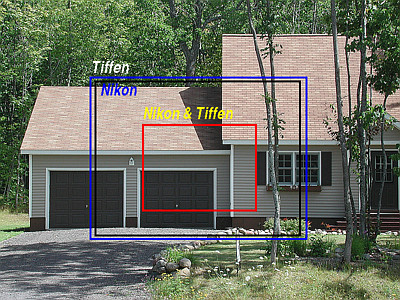
Then, we turn to image quality. The images were taken using the FINE mode. The smaller image shown below are not in their original resolution except for the last two. Click on the image to see its untouched original. Going through all images below, you should see that TC-E2 is uniformly sharper than Tiffen's 2X and has virtually no chromatic aberration.
Five areas of size 450×450 are cropped from each image. They are the center, upper-right corner. lower-right corder, lower-left corner, and the light between the two garage doors. The upper-left corner is not considered because the texture there is very similar to that of the upper-right corner.
The center portions of both lens are very good, and show the details in the shadow. But, all corner areas by Tiffen's are soft while TC-E2 maintains sharpness edge-to-edge. For Tiffen's 2X, the grid texture on the roof is blurred, although recognizable; brushes of the small garden in the lower-right corner do not have a clear definition; gravels in the lower-left corner cannot be recognized; and chromatic aberration occurs (see the purple fringe along garage door edge, and the greenish fringe between the gravel and the garage door.) Finally, the images of the garage door light, which are crops of the untouched originals, tell the whole story. The small lamp is still visible in TC-E2's shot!
| Nikon TC-E2 | Tiffen 2X | |
| Center |

|
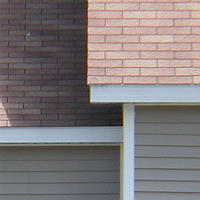
|
| Upper right corner |
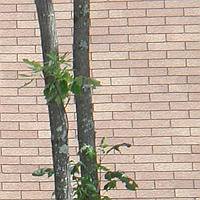
|
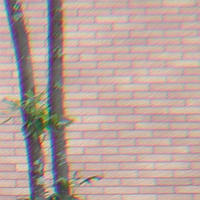
|
| Lower right corner |
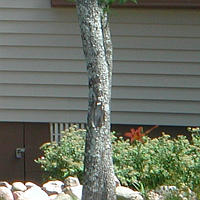
|

|
| Lower left corner |
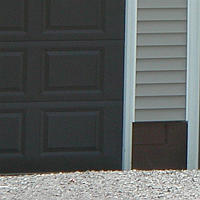
|
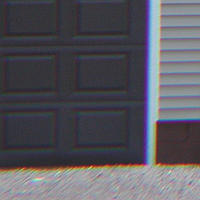
|
| Garage light | 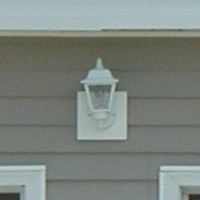
|
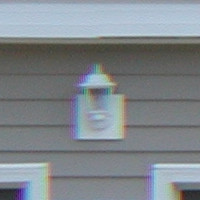
|
| Click on the image to see a larger one | ||
So, my conclusion is that if the image size you need is not large (e.g., 800×600), Tiffen's 2X converter performs very well. Moreover, if you carefully frame your subjects in the center portion, you can crop it and still have an image of good quality. This is what people said: you get what you pay for. We cannot ask a inexpensive lens to deliver too much.
Image quality can be improved by using a smaller aperture. The left image below was shown earlier and was taken with the largest possible aperture (Nikon+Kenko combo). The texture of the garage door is barely seen. If the smallest aperture is used, vignetting become more serious (i.e., the image circle shrinks), and the door texture is clearly visible. Hence, Kenko 5X is very good in terms resolution; however, with such a small image circle, this combo is perhaps not very useful.

|
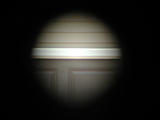
|
| Large aperture | Small aperture |
| Click on the image to see a larger one | |
The following images were shot with the Nikon+Kenko or the Nikon+Tiffen combo except that the first sunset image was taken with the Kenko 5X. The Kenko 5X seems coated because its glass has a pinkish reflection. However, the left image below shows some internal reflection, which means the coating may not be very effective. The Nikon+Tiffen does not show strong internal reflection. All images were taken in the A-REC mode with exposure compensation +1 stop. In this way, the sun will not become a completely washed-out white disk and at the same time the water (actually Lake Superior) is still visible.
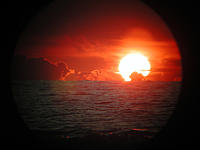
|
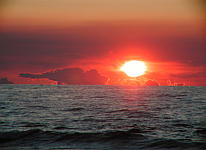
|
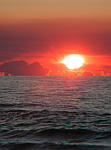
|
| Kenko 5X | Nikon+Tiffen | Nikon+Tiffen |
| Click on the image to see a larger one | ||
The following three images were taken in a park. The goal is to see how sharp we can get with these combos. Since Nikon+Tiffen and Nikon+Kenko have focal lengths 460mm and 1150mm, respectively, I want to know if they are good enough for bird watching.

|
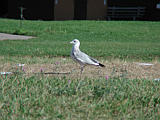
|
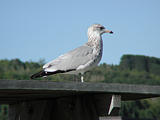
|
| Nikon+Kenko | Nikon+Tiffen | Nikon+Tiffen |
| Click on the image to see a larger one | ||
One key point of taking bird pictures is that we need to make their eyes as sharp as possible. The following shows the untouched original 200×200 crops. There is no doubt that the Nikon+Kenko cannot compete in terms of sharpness. The Nikon+Tiffen combo performs very well. The second one is ruined by chromatic aberration. So, I founded another bird who was not very afraid of human, moved closer, and took a shot. Chromatic aberration is still there; but somewhat minimized. The eye is now sharp! If you sharpen it a little with an image editor, you will get a much better result.
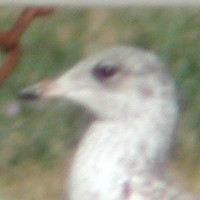
|

|
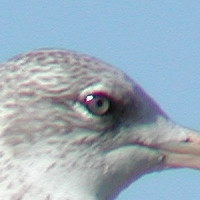
|
| Nikon+Kenko | Nikon+Tiffen | Nikon+Tiffen |
The following images are shots of some distant subjects. The boat is near the lower-right corner of the waterfront condo shot discussed earlier. This image is capable of capturing many details, although overall it is a little soft. The play ground is about 300 yards away. As you can see, except for the corners, the Nikon+Tiffen combo delivers a sharp image. The details of the wood texture in shadows are shown vividly. The last image shows that the Nikon+Tiffen did not miss the water drops in air and the reflection on the ground!
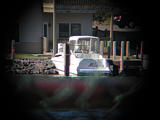
|

|
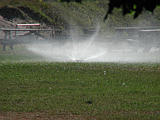
|
| Nikon+Kenko | Nikon+Tiffen | Nikon+Tiffen |
| Click on the image to see a larger one | ||
Here are my conclusions: